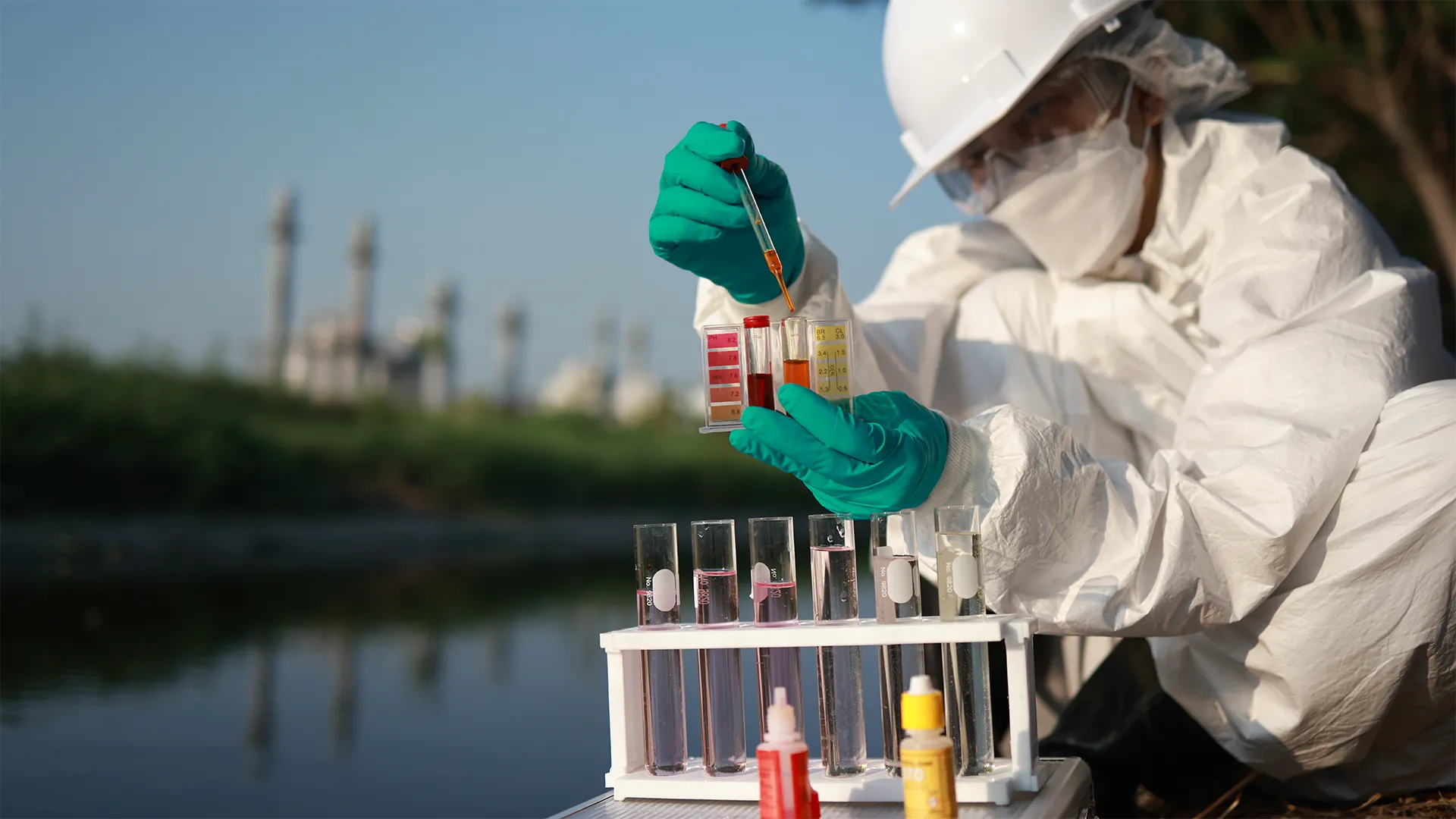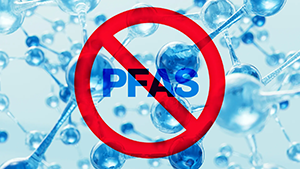PFAS: standards to make the invisible visible

The Forever Pollution Project (represented by Le Monde in France), a collective of whistle-blowers, is now a law for PFAS. On Thursday February 20, 2025, the “anti-PFAS” bill put forward a year ago by Nicolas Thierry (EELV, Gironde) was adopted by the French National Assembly, albeit without a number of its previous provisions.
The text no longer mentions PFASs found on cookware in contact with food, such as PTFE in non-stick pans, in response to the protests of certain manufacturers. On the other hand, some of these eternal pollutants will be banned from 2026 in several sectors: cosmetics, ski wax and clothing textiles, excluding technical textiles for industrial use. The Senate had already given the green light in May 2024. On another front, the text calls for PFAS monitoring to be integrated into drinking water control procedures, and for the introduction of a fee aimed at manufacturers based on the polluter-pays principle.
PFAS, yes, but which PFAS? With almost 15,000 molecules identified, 17,000 heavily polluted sites in Europe, between 52 and 84 billion euros per year in health costs in Europe due to cancers and suspected endocrine disruption (figures reported by The Forever Pollution Project), the dossier is so thick that one wonders why we didn’t hear about it before. Above all, it’s a dizzying array of per- and polyfluoroalkylated substances, numbering in the thousands and stretching to infinity through minute molecular variants.
Per- and polyfluoroalkyl substances: a bottomless pit
 Let’s start with a technical reminder. What are PFAS? They’re molecules that mankind began to manufacture after the Second World War,” explains Florian Lahrouch, standards project manager at AFNOR (sustainable and societal transitions department). They are very interesting for industry because of their mechanical properties, heat resistance and water repellency. They were very useful to us, until we realized that they generated pollution, with the very first scandal surrounding an American DuPont factory, in 2005.”
Let’s start with a technical reminder. What are PFAS? They’re molecules that mankind began to manufacture after the Second World War,” explains Florian Lahrouch, standards project manager at AFNOR (sustainable and societal transitions department). They are very interesting for industry because of their mechanical properties, heat resistance and water repellency. They were very useful to us, until we realized that they generated pollution, with the very first scandal surrounding an American DuPont factory, in 2005.”
At the time, it was PFOA (perfluorooctanoic acid), used in Teflon, the famous non-stick coating. On our side of the Atlantic, the European Food Safety Authority was only consulted in 2015 by the European Commission, and has begun to set maximum exposure limits for the main PFASs, such as PFOA since July 2020 and PFHxS (perfluorohexane sulfonic acid) since June 2022. But here’s the problem: PFASs change form quite easily: “The regulations deal with the subject molecule by molecule, not by family. So it’s easy to get round the bans by simply adding molecules to a chain,” explains Maud Liron, Water Cycle and Biodiversity Development Manager at AFNOR.
In the space of sixty years, the problem exploded. PFAS are multiplying and, while exceptionally resistant, they have the defect of their qualities: we can’t get rid of them. PFAS pollution is spreading in water, air and soil all over the planet: each publication by the Forever Pollution Project brings its own surprises, and PFAS have even been detected in Antarctica! PFAS can be found in almost every product we touch or wear. “It’s sprawling. But to confirm this, we need reliable, consensual detection methods, specific to each environmental sample,” adds Maud Liron.
NF EN 17892, for measuring PFAS in drinking water
 This is how AFNOR came into play: to be alarmed, you need to measure, and to measure, you need standardized protocols. In June 2024, the first voluntary standard for the detection and measurement of PFAS in drinking water, NF EN 17892, was published, adopted throughout Europe and using the liquid chromatography-tandem mass spectrometry (LC-MS/MS) method. A godsend, at a time when Article 1 of the brand-new law calls for PFAS to be included in drinking water control procedures (precise list to be determined by decree) and for an interministerial action plan to be drawn up to finance the depollution of drinking water! The experts on AFNOR’s standardization committees are currently working on all fronts, from sewage sludge to gaseous PFAS in ambient air, not forgetting PFAS in leather and footwear.
This is how AFNOR came into play: to be alarmed, you need to measure, and to measure, you need standardized protocols. In June 2024, the first voluntary standard for the detection and measurement of PFAS in drinking water, NF EN 17892, was published, adopted throughout Europe and using the liquid chromatography-tandem mass spectrometry (LC-MS/MS) method. A godsend, at a time when Article 1 of the brand-new law calls for PFAS to be included in drinking water control procedures (precise list to be determined by decree) and for an interministerial action plan to be drawn up to finance the depollution of drinking water! The experts on AFNOR’s standardization committees are currently working on all fronts, from sewage sludge to gaseous PFAS in ambient air, not forgetting PFAS in leather and footwear.
While the forthcoming regulatory arsenal remains very unclear, as it is subject to strong pressure, one thing is certain: France, which has been followed by Denmark, is ahead of the game. Under the 2023 interministerial plan, AFNOR is supporting the French government in its impact inventory,” continues Florian Lahrouch. We are also working on our industry’s dependence on PFAS and on present and future alternatives. Standardization won’t be the source of tomorrow’s innovations, but it can provide the confidence needed to implement them. ” For example, on the subject of fire-resistant clothing, items which are coated with a product containing PFAS, and which would lose none of their effectiveness if an alternative were to be found. So, for the time being, we’re more in the measuring than in the confrontation mode, but there’s a real risk that the debate will become stormy. AFNOR’s role is to bring together representatives of opposing interests. To preserve competitiveness and innovation while protecting
Among the manufacturers involved in standardization is SNCF. Mégane Dellal, standardization advisor at the Interoperability, Standardization & Research Europe department, confirms that her group needs to have methods of determination at its disposal, “To find an alternative to PFAS can be very complicated, if only to find suppliers or components with equivalent performance. “Looking for an alternative to PFAS can be very complicated, if only to find suppliers or components with equivalent performance”. she adds. We’re still in the early stages: “We need to make sure that the transition is feasible,” insists Mégane Dellal.
A common language for detection, sampling, analysis and comparison
We’re learning as we go; not all PFAS have been analyzed yet,” confirms Xavier Chaucherie, Sarpi’s Director of Innovation and Processes. If there are to be regulatory thresholds, we need to have the same sampling and analysis standards throughout Europe. ” As part of the Veolia group, which incinerates hazardous waste in France and Europe (4,000 employees and 110 sites), Sarpi began work on this project in 2021, based on questions raised by experts from Belgium. At the time, it was an analytical desert, but we’ve come a long way since then,” continues Xavier Chaucherie. Thus, in 2024, Sarpi joined the AFNOR standardization committee working on emissions from stationary sources into ambient air and the measurement of their concentration by infrared spectroscopy.
Among other things, this commission produced the XP X43-125 standard. “It’s very important for us to be able to measure the performance of our processes, between what comes in and what goes out of our sites. And we take care to limit incoming flows into PFAS to make sure we can achieve this: we’re not selling dreams, our business is a rigorous one”, maintains Xavier Chaucherie. Incidentally, Sarpi has patented an incineration solution: who said standardization was a brake on innovation?
Anne-Françoise Stoffel, who represents Eurofins laboratories (Saverne site) at AFNOR, agrees. Involved in standardization commissions on test methods for the environmental characterization of solid matrices and on organic micropollutants in water, she underlines Eurofins’ commitment to the development of a new standard. A standard is intended to “support innovation and share knowledge, with the aim of guaranteeing the reliability of an analytical result specifically for this family of complex and ubiquitous pollutants that are PFAS”. A standard is intended to be a reference document, representing the technical consensus among players from different analysis laboratories”. she concludes.